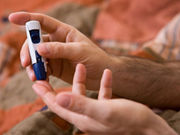Breaking sitting with standing, light-intensity walking may be alternative to structured exercise
THURSDAY, Dec. 1, 2016 (HealthDay News) — For patients with type 2 diabetes, even sitting a bit less might be of real benefit, according to research published online Dec. 1 in Diabetologia.
The new study was led by Bernard Duvivier of the department of human biology and movement science at the Maastricht University Medical Center in the Netherlands. His team wanted to see if a program to reduce sitting time — by encouraging patients to simply stand and do light-intensity walking — could offer an alternative to a standard exercise regimen.
The study included 19 adults, average age 63, with type 2 diabetes who did three programs, each lasting four days. In the first program, the participants sat for 14 hours a day and did only one hour a day of walking and one hour a day of standing. In the second program (the “sit less” program), the participants did a total of two hours a day of walking and three hours a day of standing by breaking up their sitting time every 30 minutes. In the third program (exercise), the participants replaced an hour a day of sitting time with indoor cycling. The sit less and exercise programs were designed to burn similar amounts of energy, the researchers said. Significant improvements in blood glucose control occurred when the patients did the sit less program or the exercise program, but the improvements were generally stronger during the sit less phase.
“Breaking sitting with standing and light-intensity walking effectively improved 24-hour glucose levels and improved insulin sensitivity in individuals with type 2 diabetes to a greater extent than structured exercise,” the authors conclude. “Thus, our results suggest that breaking sitting with standing and light-intensity walking may be an alternative to structured exercise to promote glycemic control in patients type 2 diabetes.”
Financial support was provided in part by Novo Nordisk; Medtronic and Roche made equipment available for continuous glucose monitoring.
Full Text
Copyright © 2016 HealthDay. All rights reserved.








